Anxious Subjects and Melancholy Romantics in a Flat Landscape
Anxious Subjects and Melancholy Romantics in a Flat Landscape (a film essay)
Judith Stewart 2016
I
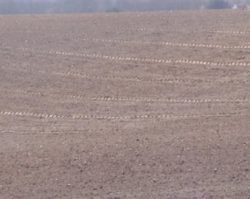
This is a space formed by horizontal lines, stillness and watery margins, both physical and conceptual. It is just one part of an on-going larger body of work that attempts to reconcile the lure of landscape with the failure of language, negotiating the murky territory where cultural, physical and psychological spaces collide, drawing connections between a particular type of landscape and melancholic longing. Much of this paper may therefore seem as if it is stumbling across a half-known space, through fog, with pitfalls, wrong turnings and occasional glimpses of something tangible in the distance. Everything is hesitant. Even the term ‘landscape’ is used reluctantly, because of the hefty cultural legacy that anchors it to notions of the Romantic Sublime or Pastoral Beauty. Perhaps, because our responses to landscape so often invoke the spectre of these, it is wise to consider them before moving on.
The cultural legacy of the Sublime, Romanticism and the Pastoral means that working with landscape as a contemporary artist can never be straightforward, as what we bring to a place or space inevitably involves some sort of negotiation between the physical space and our culturally induced readings and expectations. Once one becomes aware of the hierarchies of class and gender embedded in our understanding of these concepts and their ties to topographical entities, making landscape one’s subject matter becomes even more problematic.
Catherine Morland, Jane Austen’s unsophisticated heroine in Northanger Abbey, learns this lesson during an afternoon walk up the slopes of Beechen Cliff in Bath. Here, in the company of her cultured friends the Tilneys, she is taught “...that a good view were no longer to be taken from the top of an high hill, and that a clear blue sky was no longer proof of a fine day...” Conscious of her own cultural inferiority, she “...declared that she would give anything in the world to be able to draw; and a lecture on the picturesque immediately followed...[He] talked of foregrounds, distances and second-distances; sidescreens, and perspectives; lights and shades [so that] when they gained the top of Beechen Cliff, she voluntarily rejected the whole city of Bath, as unworthy to make part of a landscape.”(1) It is of course no accident that Catherine learns this lesson from her socially superior male companion.
I have no place in the dominant discourses of the Sublime and Romanticism, nor do I want one. Lacking the requisite masculinity to withstand the former, and somewhat repelled by the overt displays of sensibility that frequently accompany the latter, I consider myself an anxious subject of the Heidegger model, not only beset by anxieties that have a logical cause, but by that anxiety ‘...that “does not know” what it is anxious about’ .(2) As such, I find myself at home (physically and metaphorically) with my melancholia in sombre, flat landscapes.
When he wrote Of Other Spaces: Utopias and Heterotopias (3), ‘anxiety’ in relation to space was, according to Foucault, the dominant concern of the era. If this was true when it was written, it is arguably even truer in our own times, as anxiety about space (or the lack of it) has moved centre-stage. The current mass movements of people have led to a common perception that our own space is becoming ‘full’ and this, along with the combined weight of climate change, coastal erosion, loss of habitat and species extinction, population growth and the industrialisation of the countryside, makes us anxious for particular places; anxious that we do not have enough space; and, in places that are unfamiliar, we are also made anxious by space. Clearly, many of these anxieties fall into what Freud labelled ‘Reality Anxiety’(4 )– that fear of external events over which we have no control and which reduce us to the helplessness we experienced as infants. Faced with such fears, it is not surprising that anxious subjects are haunted by post-apocalyptic visions and the looming prospect of even more dysfunctional and dystopian societies.
Where anxiety ends and melancholia begins is a question for psychoanalysts, but the question arises because the anxiety I experience in relation to flat landscapes, epitomised in East Anglia where I live, seems to go hand-in-hand with melancholy. Inevitably the spectre of W.G. Sebald is raised here, and it would be foolish to discuss the East Anglian landscape without acknowledging his legacy. The Rings of Saturn (5) especially, captures the point at which the particularity of geographical features collides with the particularity of psychological space. Sebald, like many contemporary artists, used the specifics of place as a jumping-off point from which the mind can travel through time and space in order to consider its underlying anxieties. There is something about this landscape that encourages this.
Perhaps it is worth pausing a moment here to return to the term ‘landscape’. John Stilgoe reminds us that the origins of the word have nothing to do with that concept handed down through art and literature: the tangible ‘view’, solid, to be looked upon and admired from a distance. Instead, he says, it describes areas of land that have been reclaimed or forged from the sea and has its origins in the Frisian ‘landskep’ (6). So, prior to its monopolisation by advocates of the Romantic Sublime, the Anglicised word ‘landscape’ referred to something more ambiguous: something marginal and precarious. This may allow us to shift our perspective. Instead of the land being the thing that is bounded and enclosed by water, we can, as Michael Pye (7) does, begin to consider the sea as the thing that connects rather than separates: East Anglia with the Netherlands, Yorkshire to the Baltic, as it was in the Middle Ages when the Hanseatic trade routes linked these coastal areas, and when, in terms of travel time, Yarmouth was closer to Amsterdam than to London. The legacy of this, as Stilgoe demonstrates, is still evident in the remnants of a shared language that lingers along the east coast (8).
The discourse surrounding the sublime has long been embedded in the language of mountains and masculinity, and little has changed in our attitudes since the eighteenth century. Robert Macfarlane (9) for one, writing of our relationship with nature still reveres the qualities of endeavour, hardship and endurance: qualities associated with conquest, with the lone, intrepid (male) explorer. But the flat landscape is harder to contain. It cannot be conquered because there is not only no central focus on which to fix one’s gaze: there is no identifiable endpoint. Its horizontal lines shift and escape the edges of sight. Instead of hard, solid outlines rearing against the sky, thin, fragile lines appear to be holding something back, waiting for something to happen, continuing and connecting us to things beyond our peripheral vision. On the coast the tides can creep up behind and around; the sands swallow up unsuspecting walkers, children or cockle pickers. Perhaps this horizontal landscape gives the artist anxious to avoid clichés, or concepts from which she is excluded, the means to reject landscape’s inevitable links with the Romantic Sublime – even though, because of her anxious subjectivity and the long shadow cast by Romanticism, she slips in and out of Romantic melancholia.
II
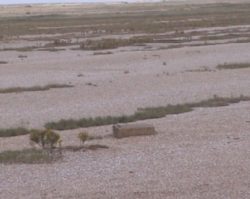
Engaging with the flat landscape as landskep perhaps makes it easier to reject not only the dominant cultural discourse of the Romantic Sublime, but also the vision of pastoral beauty which sends us in search of a nostalgic, non-existent past. The flat landscape, because it lacks a dominant cultural discourse (other than to be dismissed as ‘boring’), gives us a space on which to project. So, in suggesting that landscape is an abstract concept or mental construction, i.e. its psychological and cultural aspects are as important as its geographical features, what we perceive must therefore be formed by our psychological and cultural landscapes as much as the physical geography. This is not to suggest that landscape is a mirage or lacks physical form, but that how we think about it, and what it represents, comes from within ourselves rather than from any inherent geographical or geological qualities.
Just as in the 18th century the domestication of the countryside led to a desire for mountains and wilderness in a search for the sublime, today, in a world whose contours have shrunk through technology, we increasingly long for the few remaining wildernesses. But in landskeps there are no wildernesses of the Romantic model: here the wilderness involves making a step into that ‘nothingness’ that lies beyond our perception. There is perhaps something about how we imagine these spaces that encourages us to project onto them our unfulfilled desires, discontents and anxieties.
III

East Anglia is an awkward place. It conforms neither to the 'masculine', rugged, sublime nor the 'feminine' idyllic, pastoral beauty of the English countryside that inhabits prime time television and weekend colour supplements, and which prompts urban dwellers to seek a different way of being. Its undramatic landscape is not only the very antithesis of the sublime landscapes long favoured by artists, being flat and intensively cultivated, it also, lacks the pastoral beauty conjured up in most visions of rural life.
Nature in its ‘unspoiled state’ is hard to find in East Anglia. The inexorable march of industrial agriculture has produced a region that is highly regimented and controlled. The small mixed farms of my childhood have all but disappeared, replaced by arable monocultures of potatoes, sugar beet, rape and barley – the very embodiment of agri- business. It can as J. M. Coetzee observes, be very bleak with small farms being swallowed up by large conglomerates, and replaced “with asylums or prisons or homes for the aged or testing ranges for weapons”(10).
Freud’s Reality Anxieties are clearly in his thoughts as he continues, noting that: “[m]any of our anxieties relating to space are clearly beyond our control as individuals, so we attempt to alleviate them by finding (or creating) our own physical and psychological spaces where we can ‘belong’; where we can have our own space.”(11)
But while much of the region is highly controlled, at the edges it is rapidly slipping away – literally – giving rise to another sort of anxiety, as one cannot avoid being constantly aware of places that are now submerged. Sebald observes that Dunwich, once a bustling port, “...has gone under, quite literally, and is now below the sea, beneath alluvial sand
and gravel”.(12) Whilst the case of Dunwich is well known, there are others less talked about. Out beyond Cromer pier lies Shipden, another settlement under water, and every winter sees anxious speculation about other villages that will soon be lost.
IV
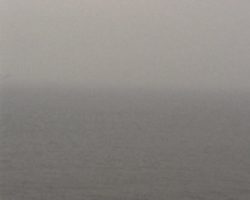
“The region”, says Sebald, “is so empty and deserted that, if one were abandoned there, one could scarcely say whether one was on the North Sea coast or perhaps by the Caspian Sea or the Gulf of Lian-tung”.(13) But what is this ‘emptiness’ – if there can possibly be such a thing – of which Sebald speaks and which compels me to make work that draws on this space?
Even though mountains and rolling hills have become yardsticks for the sublime and beauty respectively, history makes it clear that our experience of, and cultural reaction to, places is not stable. Samuel Johnson for one, travelling through the Western Isles of Scotland in 1775 considered nature to be at its best when cultivated. He found himself “...astonished and repelled by this wide extent of hopeless sterility...” when encountering the Scottish wilderness.(14) The letters of the 15th century Paston15 family portray Norfolk not as the quiet rural backwater it is considered today, but as a highly dangerous place, full of anxiety, where, once one travelled seven or eight miles beyond one's familiar
surroundings, there was real danger of getting hopelessly lost or becoming the victim of random violence. Whilst this change can be explained away, to a certain extent, by social changes in the form of changing technologies and modes of transport, we should not overlook the subtle influence on our perception of changes to the physical landscape. The road to Yarmouth mentioned in the letters, like Dunwich and Shipden, also lies in the sea.
It is this relentless wetness around the edges – that sometimes comes with violent surges but is more usually a seeping, shifting presence, combines with the inhospitable interior to make the whole place – to me - seem poised on the edge of destruction.
V
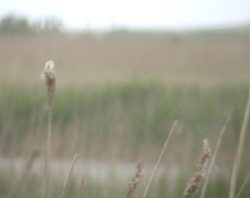
When people speak of the East Anglian landscape, it is not its emptiness that is noted, but its big skies. It is as if in this region, the sky is the nearest a viewer can come to experiencing the Sublime. However, I would argue that it is not the skies, but the flatness of the land and the space this creates between oneself and the horizon that encourages anxiety or melancholia. This opens a space that is emphasised when a human figure is introduced, making us experience it not as something empty, but as something that is perhaps already filled with our anxieties. The significance of what Didier Maleuvre calls ‘the human hyphen’ is crucial here, and his observations on the desert are pertinent to any flat landscape in which “...creation [is] pared down to its core elements: sky, earth and the human hyphen that stands in between.”(16)
In her essay on Holbein’s Dead Christ, Kristeva speaks of the profound change wrought by the Reformation on the northern European psyche.(17) By removing the idea of an intermediary between the individual and God, she argues, the individual is left exposed to the realisation that there was no longer anything between oneself and God and that therefore, ultimately, we are alone.18
There are clearly echoes of this in the dwarfed figures engulfed by the emptiness of the East Anglian landscape and in what Coetzee notices in The Rings of Saturn which he suggests was written in order “to tame the ‘paralyzing horror’ that overtakes its author – that is to say its ‘I’ figure – in the face of the decline of the eastern region of England and the destruction of its landscape”(19) All Sebald achieves, Coetzee says, is confirmation of “what at the deepest level his people already know...that there is no cure, no salvation.”(20)
VI
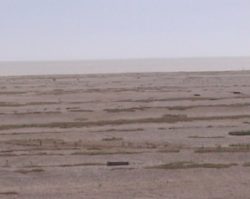
So we look towards the horizon: that symbol of desire and the place towards which we move in expectation and hope. But, as Rebecca Solnit notes, we treat desire as a problem to be solved or as something that can be satisfied. But she too mentions the importance of distance here, which she says, “...fills the space in between with the blue of longing...” However, this longing cannot be “...assuaged, by acquisition and arrival...[because] something is always far away.”(21)
In parts of East Anglia, one can never be certain of where the horizon is located: it is often indistinct, a blue-grey fuzz that creates a sense of uncertainty as to what one is seeing. One cannot even be certain of whether, in moving towards the horizon, one will be on land or water, for these elements are often interchangeable. But it is not only the ambiguity of land, sea and sky that creates this sense. The colours of the landscape contribute to this sense of walking into a shifting, blank canvas that embodies one’s anxieties. Frequently monochromatic and drained of all but subdued colour, the blanks that are filled in only serve to isolate and emphasise the figures that hover in the overwhelming space.
Whilst the visitor to the East Anglian landskep can experience something of the magnitude of the openness of this space, that experience is unlikely to mirror the images I conjure here. Go to the Blakeney marshes at any time of the year, and you will find the emptiness filled with twitchers, metropolitan families in search of the periphery. But stand for long enough, shift your gaze away, frame the space so that the resulting image refuses identification and instead ‘...blurs the boundaries between the real and imaginary”(22) and the possibility of another way of thinking landscape begins to be possible.
Returning to the desert analogy, “What else is there to say in this primal nakedness?” asks Maleuvre. “The desert pares down being to a heart-sinking geometric austerity: here I am. Where else can one ever be?...The desert makes this eye-burningly clear: I ever see things but from where I stand, from here. And the ‘here’ of the desert has this peculiarity that it lets me see, proverbially, as far as the eye can see. I perceive the extent of my perception all the way to its very edge, which looks like, but is not, the edge of the world. Here I am therefore means also: here I self-knowingly stand.”(23)
Judith Stewart 2016
References
1 Jane Austen Northanger Abbey, Dent & Co, London, 1895 5th ed, pp.103-4.
2 Martin Heidegger, Being & Time Trans. Joan Stambaugh Albany: State University of New York Press 1953 p186).
3 Michel Foucault, Of Other Spaces: Utopias and Heterotopias, 1967
4 Sigmund Freud, ‘Mourning and Melancholia’ in The Penguin Freud Reader I ed Adam Phillips London, Penguin,1917, pp310-326
5 W.G. Sebald, The Rings of Saturn Trans. Michael Hulse. London: Harvill Press, 1998 6 John Stilgoe, What is Landscape? London, MIT Press 2015
7 Michael Pye, The Edge of the World: How the North Sea Made Us Who We Are London, Penguin Random House, 20148 Stilgoe
9 Robert Macfarlane, Mountains of the Mind: a History of a Fascination London, Granta, 2008
10 J.M. Coetzee, ‘After Nature’ in After Sebald pp 85-93 ed Jon Cook, Full Circle Editions, Framlingham, 2014.
11 (Coetzee, 2014:)
12 W.G. Sebald, The Rings of Saturn Trans. Michael Hulse. London: Harvill Press, 1999, p155
13 ibid 1998
14 A Journey To The Western Islands Of Scotland
[A "Pristine Wilderness"] by Samuel Johnson (1775) 15 The Paston Letters
16 Didier Maleuvre, The Horizon: A History of Our Infinite Longing London, University of California Press 2011, 73.
17 Kristeva 1987 p5
18 Julia Kristeva, Black Sun: Depression and Melancholia trans. Leon S. Roudiez Columbia
University Press, New York, 1989
19 Sebald 1998 p87
20 Coetzee, 2014:86
21 Rebecca Solnit, A Field Guide to Getting Lost Canongate: Edinburgh, 2006, pp30-31
22 Sebald 2007p108 Scholz, C. (2007) ‘But the Written Word is Not a Document: A Conversation with W.G. Sebald on Literature and Photography’ in Searching for Sebald: Photography After Sebald ed. Lise Patt, Los Angeles: ICI Press (pp 104-109).
23 Maleuvre, 2011: pp65-6
